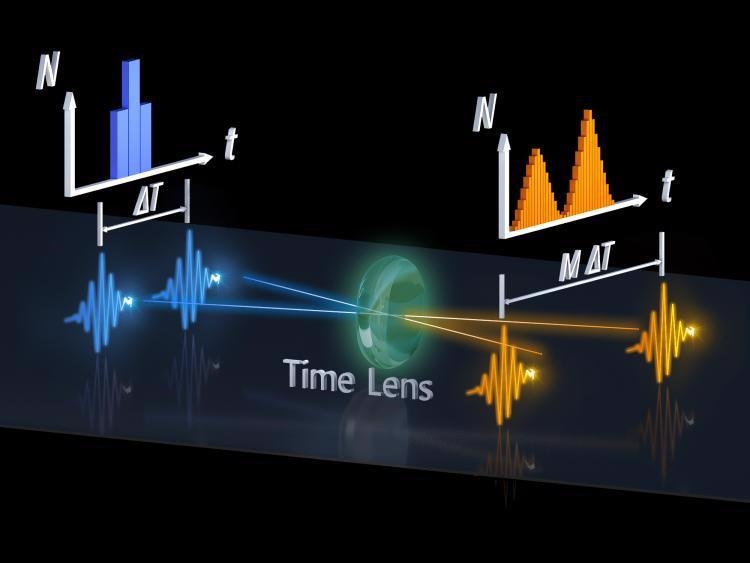Reviewed by Alex SmithAug 25 2021
Scientists from the University of Colorado Boulder have designed one of the most accurate stopwatches. Unlike the ones to record timings in the Olympics, this stopwatch is used for counting single photons, or the tiny packets of energy that form light.
 Graphic showing how a time lens can distinguish between two photons arriving at a detector close together. Image Credit: Optica.
Graphic showing how a time lens can distinguish between two photons arriving at a detector close together. Image Credit: Optica.
The invention could contribute to the development of an array of imaging technologies, ranging from sensors that map out an entire forest to more complex devices capable of diagnosing human diseases like cancer and Alzheimer’s.
The study was published in the journal Optica. The lead author of the study, Bowen Li, stated that the study concentrated on a commonly used technology called time-correlated single-photon counting (TCSPC).
The device’s operation is similar to the timers seen in the Olympics. The researchers first introduced a laser light at a sample of their choice, starting from individual proteins all the way up to a massive geological formation. Then, they noted the photons that bounced back. The understanding of the object grows upon analyzing more and more photons.
TCSPC gives you the total number of photons. It also times when each photon hits your detector. It works like a stopwatch.
Bowen Li, Postdoctoral Researcher, Department of Electrical, Computer and Energy Engineering, University of Colorado Boulder
The performance of the stopwatch has been enhanced by using an optics tool called “time lens.” The team demonstrated their ability to measure the arrival of photons with accuracy more than 100 times better than the existing tools.
The corresponding author of the study, Shu-Wei Huang, states that the quantum time lens developed by the team works with even the cheapest TCSPC devices available on the market.
We can add this modification to almost any TCSPC system to improve its single-photon timing resolution.
Shu-Wei Huang, Assistant Professor, Department of Electrical, Computer and Energy Engineering, University of Colorado Boulder
The research is part of the newly launched, $25 million Quantum Systems through Entangled Science and Engineering (Q-SEnSE) center led by the University of Colorado Boulder.
Photo Finish
Huang stated that even though TCSPC is not popular, the technology launched in 1960 has revolutionized the way humans see the world. These photon counters are the key components of lidar (light detection and ranging) sensors. These are employed by researchers to create geological maps.
They also reveal a more small-scale imaging technique called fluorescence lifetime microscopy. Doctors use this approach to diagnose certain illnesses like cancer, Alzheimer’s disease and macular degeneration.
People shine a pulse of light on their sample then measure how long it takes to emit a photon. That timing tells you the property of the material, such as the metabolism of a cell.
Bowen Li, Postdoctoral Researcher, Department of Electrical, Computer and Energy Engineering, University of Colorado Boulder
Conventional TCSPC tools can only measure the timing down to a certain level of accuracy. In case two photons arrive at the device in a close range, for instance, at 100 trillionths of a second or less apart, the detectors tend to record them as a single photon. It is similar to a situation where two sprinters reach the finish line close together.
Such tiny inconsistencies may seem to be a minor fault. However, according to Li, they may cause major discrepancies when attempting to obtain a detailed look at the incredibly small molecules.
Time Lenses
The research team decided to solve the issue using the “time lenses,” as referred by the scientists.
“In a microscope, we use optical lenses to magnify a small object into a big image. Our time lens works in a similar way but for time,” Li commented.
To comprehend the workings of time distortion, imagine two photons as two runners racing neck-to-neck, so close that Olympic timekeepers are unable to tell them apart. The team passed both the photons through their time lens, which is formed of loops of silica fibers.
In this process, one of the photons slows down, and the pace of the other increases. Here, instead of ending as a closing race, a large gas is seen between the runner, which can easily be recorded by the detector.
“The separation between the two photons will be magnified,” noted Li.
The researchers uncovered that the strategy works: TCSPC devices with built-in time lenses are capable of differentiating photons that arrive at the detector with a gap of several hundred quadrillionths of a second. This is an order of magnitude that is better than the performance of any of the normal devices.
There is some more work required before the lenses find application in scientific labs. However, the researchers believe that the tool will enable humans to view objects sized from the very small to the very large, in much higher clarity.
Journal Reference:
Li, B., et al. (2021) Time-magnified photon counting with 550-fs resolution. Optica. doi.org/10.1364/OPTICA.420816.